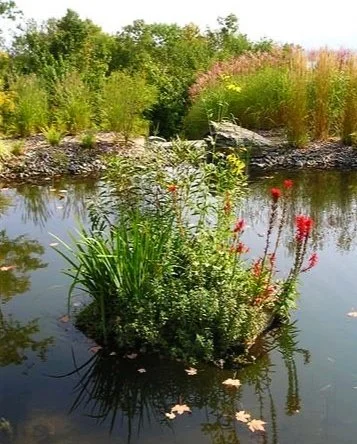Floating Islands
By Grace Kurman
Innovative Solutions to Combat Toxic Algae
One man’s floating inventions utilize “biomimicry” to combat the growth of aquatic dead-zones.
In the summer of 2000, mechanical engineer Bruce Kania was fishing on his family's pond in Shepherd, MT, when he noticed a foul smell coming from his black lab’s coat, which had alarmingly turned red after a swim.
"He realized something was very wrong with the water," Anne Kania, Vice President of Floating Islands International and Bruce’s wife, explained.
Nutrient overload and runoff from the fertilizer of an upstream farm had been polluting the water, resulting in harmful algae blooms. Bruce Kania, motivated by this discovery, began researching how he might create a system that could both clean the water, and restore the ecosystem. He found inspiration in the lakes of northern Wisconsin, which—according to Anne Kania—is “the best fishing and freshest water he had ever experienced.”
Lakes in northern Wisconsin are home to natural floating islands: unique land masses found throughout the lakes that encourage the growth of microorganisms and plant life. Floating islands propagate diverse ecosystems, reducing nutrient overload by introducing competition for existing resources. This process balances out an ecosystem, improves water quality, and increases fish populations.
“We employ our floating islands to revive the food web of a water body.”
- Anne Kania
Photo by Anne Kania
After creating over 400 prototypes, Bruce Kania achieved success by learning to imitate the islands using “biomimicry,” a process of modeling natural systems with man-made materials. By creating a biofilm base on his islands, he was able to incorporate trees, grasses, and annual flowers—making the artificial islands appear and function identically to the natural islands found in Wisconsin. With this accomplishment, the Kania family founded Floating Islands International in 2005. It has since become a worldwide distributor, having launched over 9,000 man-made islands globally. Their inventions have proven to be successful at reducing nutrient overloads that cause harmful algae blooms, whose dangerous growths create toxins detrimental to fish and any small animals that consume them.
"We employ our floating islands to revive the food web of a water body. This promotes biodiversity and healthy competition for the excessive nutrients that are causing algae blooms. The algae no longer get a free ride, and the food web kicks in to balance out the ecosystem,” Anne Kania clarified, continuing with discussions on the large-scale impact that toxic freshwater has on the environment.
“Once in a water body, toxins caused by harmful algae slowly move up the food chain…”
- Grace Kurman
Photo by Anne Kania
Once in a water body, toxins caused by harmful algae slowly move up the food chain, infecting people and animals that may not have been in direct contact with the algae. Anatoxin-a—a toxin produced from algae blooms—infects air as well as the water it grows in: killing species and creating dead zones. Currently, the biggest dead zone is found in the Gulf of Mexico: a 5,840 square-mile graveyard caused by nutrient runoff from the Mississippi river. Dead zones are areas in a body of water containing minimal oxygen, making it impossible for aquatic life to survive. Ultimately, any animals stuck in dead zones that don’t leave eventually die and decompose. Warm temperatures, higher carbon dioxide levels, and rising sea levels have all promoted the formation of algae blooms—resulting in ever-more toxic freshwater sources. Right now, the Kania family projects that these issues will only get worse.
Developing their floating islands to help combat this threat, the Kanias have begun creating a system called NanoHaven. In August 2020, they funded the capstone project for a team of engineering students at Montana State University. The team developed a solar-powered aeration system that uses complex gasses known as “nanobubbles.” When injected into the water, nanobubbles provide aquatic life with high volumes of oxygen. Current aeration systems are unable to diffuse as much oxygen into freshwater, and NanoHaven’s nanobubbles prevent the oxygen they provide from being lost by floating to the water’s surface.
Although Anne concluded our interview with some urgency, there was still optimism in her vision for a cleaner future: “Our ultimate goal is for the government and the world to recognize the impact fresh water has on the atmosphere, climate change, and global warming, and put funding into methane credits available for a full-scale clean-up of fresh water.”


